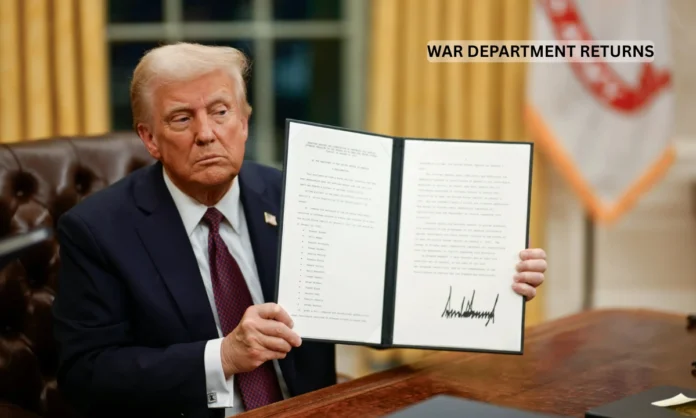Key Highlights:
- President Donald Trump signed executive order on September 5, 2025, directing the Pentagon to use “Department of War” as a secondary title, reviving a name used from 1789-1947
- Defense Secretary Pete Hegseth will now be recognized as “Secretary of War” while the administration seeks congressional approval for permanent renaming
- The rebranding effort could cost taxpayers between $300 million to over $1 billion to update signage, uniforms, and communications across 700,000 facilities globally
Historical Context and Presidential Initiative
President Donald Trump‘s executive order represents a major symbolic shift for America’s largest government department, deliberately returning to terminology that projects military strength over defensive posture. The Department of War operated under that designation for 158 years until President Harry Truman signed legislation establishing the Department of Defense in 1947 following World War II. The name change occurred as part of broader post-war reorganization that unified the Army, Navy, and newly independent Air Force under a single defensive framework.
“This name change is not just about renaming, it’s about restoring… America First, peace through strength brought to you by the WAR DEPARTMENT.” – @SecWar Pete Hegseth
— The White House (@WhiteHouse) September 6, 2025
🇺🇸🇺🇸🇺🇸🇺🇸 pic.twitter.com/dcUKZLTHYN
The executive order, officially titled “Restoring the United States Department of War,” emphasizes that the original name “signal[s] our strength and resolve to the world”. Trump argued during the signing ceremony that the Department of Defense name was “woke” and criticized the defensive mindset it represented. According to the official White House statement, the new designation “ensures peace through strength, as it demonstrates our ability and willingness to fight and win wars on behalf of our Nation at a moment’s notice, not just to defend”.
This administrative action follows Trump’s broader pattern of military-focused rebranding initiatives. The president has overseen extensive name changes across military installations and has positioned himself as restoring American military dominance through symbolic messaging. The Department of War designation specifically aims to project offensive capabilities rather than purely defensive positioning, according to administration officials.
Republican supporters in Congress have rallied behind the initiative, with Florida Representative Greg Steube stating that “from 1789 until the end of World War II, the United States military fought under the banner of the Department of War”. Senators Rick Scott and Mike Lee introduced companion legislation to codify the change into law, though the executive order enables immediate use of secondary titles without congressional approval.
Implementation Strategy and Legal Framework
- Trump’s executive order circumvents congressional approval requirements by establishing “Department of War” as a secondary designation rather than replacing the official name
- Defense Secretary Pete Hegseth has 60 days to recommend legislative and executive actions for permanent renaming
- All federal agencies must recognize and accommodate the secondary titles in official communications
The implementation strategy reflects careful legal maneuvering around congressional authority over federal department naming. While presidents cannot unilaterally rename government departments, Trump’s order authorizes Pentagon officials to use titles such as “Secretary of War” and “Deputy Secretary of War” in official correspondence and public communications. The White House fact sheet specifies that “statutory references to the Department of Defense, Secretary of Defense, and subordinate officers and components shall remain controlling until changed subsequently by law”.
Defense Secretary Pete Hegseth immediately began using his new title following the order’s signing, with Pentagon signage quickly updated to reflect the “Secretary of War” designation. The rapid implementation demonstrates the administration’s commitment to projecting the new military posture even while awaiting congressional action for permanent changes. Pentagon websites and internal communications have also begun incorporating the Department of War branding in official contexts.

The legal framework requires careful coordination across executive departments to avoid conflicts with existing statutes and international obligations. The executive order mandates that secondary title usage “does not create confusion with respect to legal, statutory, or international obligations”. This provision acknowledges the complex web of treaties, agreements, and legal documents that reference the Department of Defense by its current name.
Congressional Republicans have shown strong support for formalizing the change through legislation. The narrow Republican majorities in both chambers suggest likely passage of bills introduced by Scott, Lee, and Steube to make the renaming permanent. However, the administration appears prepared to operate with secondary titles indefinitely if congressional approval proves challenging.
Financial Implications and Operational Costs
- Conservative estimates project rebranding costs between $300 million to $1 billion for comprehensive updates across global military installations
- The Pentagon operates over 700,000 facilities across 40 countries requiring signage, communication, and branding updates
- Previous military base renaming efforts cost approximately $39-62.5 million, providing scale reference for the Department of War transition
The financial scope of renaming the world’s largest military organization presents significant budgetary challenges. Pentagon employees and defense analysts have expressed concerns about the costs associated with updating everything from official stationery to embossed dining facility napkins across the Department’s massive global footprint. The rebranding would encompass changes to uniforms, patches, seals, office nameplates, digital systems, email addresses, and countless other branded materials used by the 2.9 million military and civilian personnel.
Media analyses suggest the total cost could exceed $1 billion when accounting for comprehensive updates to legacy systems, international installations, and operational equipment. These projections draw comparisons to previous renaming efforts, including the Biden administration’s renaming of nine Army bases that honored Confederate leaders, which required $39-62.5 million in taxpayer funding. However, the Department of War transition involves exponentially more facilities and personnel than individual base renamings.
The White House has not released official cost estimates, leading to speculation about the true financial impact on taxpayers. Critics argue that spending billions on cosmetic changes diverts resources from actual military readiness and capability improvements. One former Pentagon official told Politico that the move “will cost millions and will have no effect on the calculations of China or Russia”.
Budget analysts note that the Department of War operates with an annual budget exceeding $850 billion for fiscal year 2025, making rebranding costs relatively small as a percentage of total spending. However, the symbolic nature of the expense has drawn criticism from fiscal conservatives who question allocating substantial funds to name changes rather than operational improvements.

U.S. Department of Defense Budget from FY2023 to FY2025
Strategic Messaging and International Implications
Defense Secretary Pete Hegseth emphasized the symbolic importance of the name change during the signing ceremony, stating “We haven’t won a major war since” the Department of Defense designation was adopted in 1947. This messaging aligns with the administration’s “warrior ethos” campaign designed to project American military strength to both allies and adversaries. The Department of War branding specifically aims to signal offensive capabilities and willingness to engage in conflict when national interests are threatened.
International reactions to the rebranding effort remain mixed, with some analysts warning that adversaries could exploit the change to portray Washington as increasingly militaristic. The “Department of War” designation may complicate diplomatic relationships in regions where the United States seeks to project stability and peacekeeping intentions rather than aggressive military posture. However, administration officials argue that projecting strength through clear messaging ultimately enhances deterrence capabilities.
The timing of the announcement coincides with ongoing global tensions, including conflicts in Eastern Europe and the Middle East, as well as strategic competition with China in the Indo-Pacific. Military spending worldwide reached $2.4 trillion in 2023, with the United States accounting for over 40 percent of global defense expenditures. The Department of War branding positions America’s $916 billion military budget as an instrument of active engagement rather than passive defense.
Allied nations have not publicly commented on the name change, though NATO partnerships and bilateral defense agreements continue to reference the Department of Defense in existing treaties. The administration will need to coordinate with international partners to ensure the secondary title usage does not create confusion in joint operations or formal agreements.
Final Assessment
Trump’s executive order renaming the Pentagon represents the most significant symbolic transformation of American military leadership since the Department of Defense’s establishment in 1947. While the immediate practical changes remain limited to secondary titles and internal communications, the broader implications extend far beyond administrative convenience. The Department of War designation signals a fundamental shift in how the administration views America’s military role globally, emphasizing offensive capabilities over defensive positioning.
The financial costs, estimated between $300 million and $1 billion, reflect the massive scope of rebranding the world’s largest military organization across 700,000 facilities worldwide. These expenses have generated criticism from fiscal conservatives and defense analysts who question whether symbolic changes justify substantial taxpayer expenditure when military readiness faces ongoing challenges. However, supporters argue that projecting strength through clear messaging enhances deterrence and reflects America’s historical military success under the Department of War banner.
The success of permanent renaming ultimately depends on congressional approval, though Republican majorities in both chambers suggest favorable prospects for supporting legislation. Whether the Department of War designation achieves its intended strategic messaging goals while justifying its financial costs will likely influence similar symbolic initiatives throughout Trump’s presidency. The rebranding represents a calculated gamble that military symbolism translates into enhanced global influence and deterrence capabilities in an increasingly complex international security environment.


